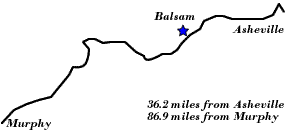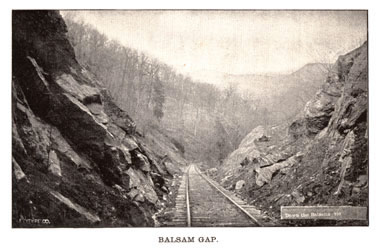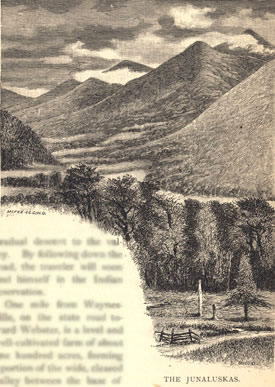Travel Western North Carolina

Following Wagon Trails - 1890s: Balsam
Jackson County, N.C.
Altitude: 3,348 feet
At Balsam Gap the railroad crossed over the line between Haywood and Jackson counties, N.C. Balsam Gap would be advertised as the highest standard railroad crossing east of the Mississippi River. At an elevation of just under 3,500 feet, the gap was noticeably higher than other points along Southern Railway's Murphy Branch. For instance, at Old Fort, N.C., immediately before the railroad climbed the Blue Ridge mountains, the elevation was less than 1,500 feet. Asheville, N.C., was a little over 2,200 feet and Waynesville, N.C., lay at an altitude of 2,635.
The picture "Balsam Gap" is from the booklet Woman's Christian Temperance Union Southern Assembly and School of Methods, Waynesville, N.C., 1892. However, a different caption is in the lower right corner of the picture, and reads "Down the Balsams." This caption and the number 916 were listed in the catalog of postcards available for purchase in Thomas H. Lindsey's 1890 book Lindsey's Guide Book to Western North Carolina.
The January 5, 1883, issue of the News and Observer (Raleigh, N.C.) carried an article that noted while the actual railroad tracks had not yet been laid west beyond the present town of Canton, N.C., nonetheless "the grading has been pushed with due diligence. The grading has been completed to the top of Balsam mountain, a distance of eighteen miles west of Pigeon river and nearly completed . . . ."
As with so many other aspects of railroad construction in western North Carolina, convict labor was employed along the line. In reporting on an inspection tour by Governor Thomas J. Jarvis, the News and Observer carried his remarks on the use of convicts in its December 23, 1882 edition. Jarvis commented in an interview that Balsam was “the first quarters of the convicts. Here we spent Tuesday night, and personally inspected the quarters, wherein are housed 160 convicts.” Jarvis also noted, “There are besides the convict quarters at the Balsam, two others between that point and the Cowee tunnel, at which are in all about 425 convicts.” Jarvis lauded the men’s quarters, a situation disputed by other observers such as Rebecca Harding Davis in her “By-Paths in the Mountains, II” (Harper’s New Monthly Magazine, August 1880), who offered a different view of the conditions under which the men labored in the rail line’s construction. In her article “By-Paths in the Mountains,” published in Harper’s New Monthly Magazine (August 1880, p. 360), Davis stated, “In a moment half a dozen camp fires started into light, and the gorge swarmed with hundreds of wretched blacks in the striped yellow convict garb. After their supper was cooked and eaten, they were driven into a row of prison cars, where they were tightly boxed for the night, with no possible chance to obtain either air or light.”
Only days after Governor Jarvis's tour of the area, nineteen of the men would die in a tragic crossing of the Tuckasegee River near Dillsboro, N.C., while being ferried across to work on the 800-foot Cowee Tunnel.
A Night in a Snow Drift: Trains on the “Ducktown Branch” Can’t Make It Against “The Fleecy.”
Special to the Observer.
“Asheville, Jan. 17. – The train on the Murphy branch of the Western North Carolina Railroad which left Asheville yesterday morning struck a snow drift on Balsam Mountain. Four extra engines were sent to aid the train in getting through, but nothing could be done, and the train, with its passengers, had to spend the night in the drift, six feet deep where it first struck. This morning the luck was better, and the drift was removed, the train reaching Murphy this afternoon. The train coming to Asheville stalled on account of snow beyond the Balsam, but was finally helped to Balsam where the passengers spent the night and arrived here this afternoon, 36 hours off schedule. The obstructions by snow are the greatest in the history of the road. The line will be open tomorrow.”
- Charlotte Observer, published as Daily Charlotte Observer, January 18, 1893, p. 1.
From America’s Historical Newspapers – Early American Newspapers, an Archive of Americana Collection, published by Readex (Readex.com), a division of NewsBank.
In recounting a trip to Waynesville, in Haywood County, N.C., Wilbur G. Zeigler and Ben S. Grosscup commented that, “Majestic mountains rise on all sides into the blue sky. Afar, Old Bald, his brethren Balsams, Lickstone mountain, and Mount Serbal, lift their heads. In lofty outlines, the Junaluska group of Balsams stand black against the glowing western sky” (p. 285). Their travel account, published as The Heart of the Alleghanies in 1883, featured a line drawing of “The Junaluskas.”
Balsam Dots By Doodle
“Monday morning was dark, cold and rainy; seemed for a while as if we were booked for another awful blizzard; but toward evening the clouds began to roll away and it became much more pleasant. Tuesday was indeed a beautiful day, although right cold.
Mr. S.E. Bryson, of Andrews, N.C., paid Balsam a short visit last week. Mr. Bryson is always a welcome visitor in our midst.
Monday an immense rock fell on the railroad track about two and one half miles below here. The rock was so heavy it could not be removed without the aid of the freight engine. Fortunately the passenger train had just passed and no harm was done.
Mr. Berry killed a wild turkey near here a short time ago.
Two large cinnamon bears were seen walking up the track one morning last week, but quite fortunately for our safety their keepers were walking along with them.”
- Waynesville Courier (Waynesville, N.C.), March 8, 1895
Return to the Southern Railway Map for the 1890s
Sources & Readings
- Jackson County Genealogical Society. Jackson County Heritage, North Carolina, 1992. Cullowhee, NC: JCGS, 1992 (Volume 1) and 2000 (Volume 2).
- Sawyer, Harriet Adams. Souvenir of Asheville or the Skyland. St. Louis: Nixon-Jones Printing Co., 1892.
- Williams, Max R., ed. The History of Jackson County. Sesquicentennial ed. Sylva, NC: Jackson County Historical Association, 2001.
- Zeigler, Wilbur G. and Ben S. Grosscup. The Heart of the Alleghanies; Or, Western North Carolina; Comprising Its Topography, History, Resources, People, Narratives, Incidents, and Pictures of Travel, adventures in Hunting and Fishing and Legends of Its Wilderness. Raleigh, N.C.: A. Williams & Co.; Cleveland, O.: W.W. Williams, 1883.


